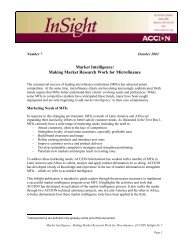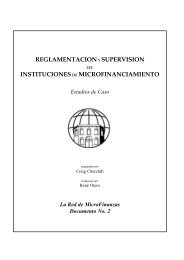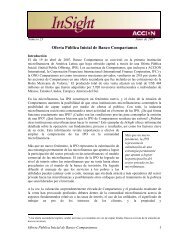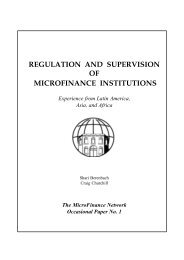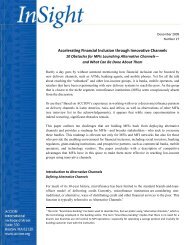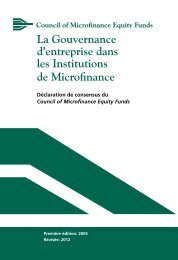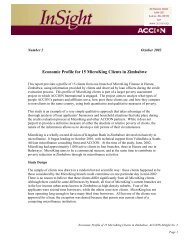the Universal Standards for Social Performance Management
the Universal Standards for Social Performance Management
the Universal Standards for Social Performance Management
Create successful ePaper yourself
Turn your PDF publications into a flip-book with our unique Google optimized e-Paper software.
Several participating institutions commented that this section was written from <strong>the</strong> perspective of a morecommercial MFI, which is not always relevant <strong>for</strong> very socially minded organizations or nonprofits withoutinvestors, <strong>for</strong> example. These comments are detailed fur<strong>the</strong>r below.Many participants logged a very high number of "don't know" answers (especially in areas 6b, 6c, and 6d)indicating that 1) many of <strong>the</strong> issues in this section require specialized finance knowledge and 2) <strong>the</strong> languageneeds to be clarified fur<strong>the</strong>r. O<strong>the</strong>rs found that <strong>the</strong>y could not respond adequately because some of <strong>the</strong> EPs weredifficult to measure or contained too many concepts (e.g., 6a1, 6a2, and all of 6b and 6c).Given that some EPs were found to be important <strong>for</strong> many institutions, but not all MFIs universally, futureassessment scores should not penalize an institution <strong>for</strong> not "complying" with an EP that does not apply to thatinstitution.Specific Practices of Note (easiest, most difficult, inapplicable, confusing, etc.)Below we have outlined EPs identified as not universally relevant by one or more institutions. The most commonissues are in bold.6a2 “The institution manages <strong>the</strong> risks associated with growth by 1) assessing market conditions to ensurethat nei<strong>the</strong>r long-term sustainability nor client well-being are jeopardized by pursuit of short-termgrowth, and 2) setting and verifying compliance with growth related policies across alldepartments/branches” – Not all departments in an MFI have growth-related policies.6b1 “The institution and its investors align up front <strong>the</strong>ir desired level of returns and how those returnswill be allocated. . .”– Not relevant <strong>for</strong> all organizations (e.g., nonprofits, organizations withoutinvestors, with regulatory restrictions).6b2 “The Board establishes desired ranges <strong>for</strong> risk-adjusted return on assets (ROA), risk-adjusted returnon equity (ROE) and o<strong>the</strong>r relevant profitability ratios, and has a rationale <strong>for</strong> how those target rangesbalance financial and social goals” – Not applicable <strong>for</strong> organizations where numbers are not set by <strong>the</strong>Board.6b3 “The institution works with investors whose expected time horizons and exit strategies are alignedwith <strong>the</strong> institution’s social goals and stage of development” – Not relevant <strong>for</strong> organizations withoutinvestors or with regulatory restrictions; in addition investors dictate time horizons and many locallenders do not have socially related goals.6b4 “The institution considers its total cost of capital when deciding on a financing structure. . .” – Notrelevant <strong>for</strong> all institutions.6b6 “The institution’s funding model protects client savings and cash collateral” – Not relevant <strong>for</strong>organizations that can't keep savings.6c2 “Do not pass on cost of inefficiency to <strong>the</strong> client” – Not relevant <strong>for</strong> all institutions.6d2 “The institution calculates <strong>the</strong> difference between <strong>the</strong> average compensation of its top levelexecutives and its field employees, and evaluates whe<strong>the</strong>r this spread is consistent with <strong>the</strong>institution’s mission. . .”– Not universally relevant given <strong>the</strong> many factors that impact compensation.While in general we recommended that EPs be adjusted to disaggregate multiple concepts, clarify complexlanguage, and incorporate measurability, we’d like to point out specific language adjustments <strong>for</strong> <strong>the</strong> following:6a1 “The institution sets sustainable target growth rates <strong>for</strong> all branches/regions and <strong>for</strong> all products,considering both internal factors (e.g., staffing, in<strong>for</strong>mation systems, financing) and external factors (e.g.,competition, market saturation, client overindebtedness” – EP asks about too many concepts and shouldbe broken down.6a2 (see above) – Includes multiple concepts of varying levels of difficulty. The language is confusing.21




